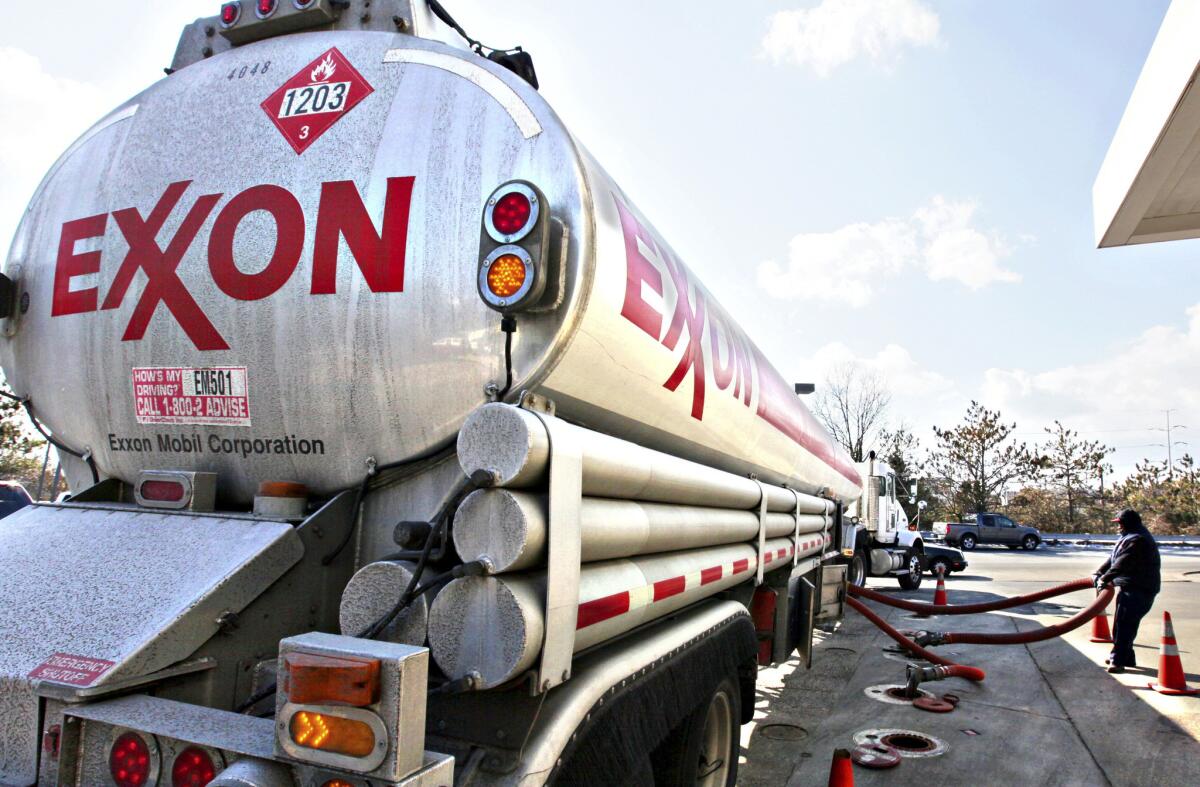Why one consumer advocate blames a mysterious ship for helping keep California gas prices high

An Exxon Mobil ship sailed for 70 days off the coast of Singapore but never picked up fuel for California from the company’s two refineries there. Above, an Exxon tanker truck.
- Share via
There’s an unusual new entry to the long list of reasons why Californians spent the last year paying significantly more for gasoline than other U.S. drivers: a mystery ship.
The explosion at Exxon Mobil’s huge Torrance refinery a year ago undoubtedly was a major factor contributing to high gasoline prices in California, especially in the Los Angeles area, fuel experts have said.
Consumer advocates contend that the oil company could have done more to bolster gasoline inventories and help lower prices, and on Monday they backed up the argument with the help of a wandering oil tanker.
SR American Progress, an Exxon Mobil ship, sailed for 70 days off the coast of Singapore but never picked up fuel for California from the company’s two refineries in Singapore that produce the state’s special blend of environmentally friendly gasoline. Jamie Court, president of advocacy organization Consumer Watchdog, told the state Petroleum Market Advisory Board that the ship stopped in Los Angeles after its Southeast Asia excursion but didn’t unload any gasoline before taking its fuel to Florida.
“We have a real troubling, dysfunctional market,” Court said during the meeting in Sacramento.
Exxon Mobil in a statement dismissed Court’s allegations without discussing the SR American Progress’ sailing records or deliveries.
“Exxon Mobil rejects these allegations and is committed to the highest standards of business conduct, has operated responsibly and in strict compliance with all laws,” said Todd Spitler, a spokesman for the oil giant.
Court and others have accused the industry of manipulating the markets to obtain record profits that some of the oil companies gained in California with the gas price increases.
Although the average California gas price typically runs higher than the national average, unusually wide gaps persisted throughout 2015, in particular between the L.A. area and the rest of the country. At one point, the average gas price in the L.A. region stood at $1.50 more than the U.S. average, with some gas stations in the city listing prices as high as $5.49 a gallon.
SIGN UP for the free California Inc. business newsletter >>
The national average Monday continued its steepest decline in years to $1.74 for a gallon of regular gas. But the Los Angeles area maintained its stubborn position almost a dollar higher at $2.66, according to AAA’s daily survey of fuel prices.
“This is the most unusual year … that I have seen in my 50-year career,” Bob van der Valk, a petroleum analyst, told the advisory panel.
Troubles began with the Feb. 18 explosion at the Torrance refinery. The explosion destroyed a pollution control system and crippled the facility so much that it produces less than 20% of its normal capacity.
With the Torrance plant at a fraction of normal production levels, the market in Southern California became strained. That refinery provides 10% of the state’s overall capacity and 20% in Southern California.
Van der Valk said that more imports would have blunted the effect of the crippled Torrance facility. But he said the market thought the plant would return to service by July, even if only with a temporary fix. Then there was talk that Exxon would increase production by year’s end.
Neither happened. And now the plant isn’t expected to return to full capacity until sometime before Exxon Mobil sells the plant to contracted buyer PBF Energy, a Parsippany, N.J., firm, in the second quarter of this year.
In Court’s estimation, Exxon Mobil could have helped replenish dwindling gasoline stockpiles in California, but instead the company contributed to the drain on available resources within the state.
Join the conversation on Facebook >>
Court pointed out that a second ship arrived in Los Angeles from Singapore in three weeks at Exxon’s behest last year — but only after, he contends, the oil company faced some challenges in meeting demand.
“If Exxon had used its flagship,” Court said, “we wouldn’t have had this kind of problem.”
Severn Borenstein, chairman of the advisory panel, challenged some of Court’s assertions. Borenstein questioned why Exxon would spend more money buying up expensive gasoline in the market instead of importing fuel at cheaper prices.
“That piece of the story doesn’t make much economic sense,” Borenstein responded to Court.
Gordon Schremp, senior fuels analyst for the California Energy Commission, said it is difficult to know what Exxon Mobil’s intent was in regard to the SR American Progress, given that the company also is a supplier to other locations across the country and the world. Schremp added that Exxon Mobil met its contractual obligations in California.
Exxon Mobil sold 4% more gasoline in 2015 than in 2014, Schremp said. The company did that in part by buying gasoline from other companies with the Torrance facility not at full production levels, he said.
Twitter: @ivanlpenn
MORE BUSINESS COVERAGE
Why Canada is better at disrupting the corporate status quo
5 futuristic oddities from the weird world of wearable tech
Hiltzik: Why Apple fans are really coming to hate Apple software
More to Read
Inside the business of entertainment
The Wide Shot brings you news, analysis and insights on everything from streaming wars to production — and what it all means for the future.
You may occasionally receive promotional content from the Los Angeles Times.











